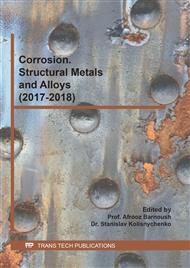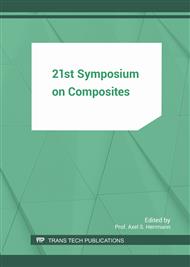p.434
p.440
p.447
p.457
p.463
p.473
p.482
p.490
p.498
3rd Generation Hot-Dip Galvanized Steel Sheet for Automobile Manufacturing - Interface Reactions between Zinc and Metal Oxide
Abstract:
There is a growing demand for Advanced High Strength Steels (AHSS) in the automotive industry owing to their high specific strength and good formability. The mechanical properties satisfy the demands for improved passenger safety and decreased vehicle weight due to thinner cross sections. Hot-dip galvanizing is a common procedure to prevent corrosion of steel, galvanized steel forms the basis for further processing like organic coating. Industrially, the steel strip is annealed at 840 °C in 5 % H2 in N2 at a dew point (DP) of -30 °C. These conditions are reducing for Fe, but oxidizing for oxygen-affine alloying elements as Mn, Si and Cr. These ignoble elements form an external, covering oxide layer on the steel surface, which exhibits poor wettability for the Zn(Al, Fe)-bath. The liquid Zn(Al, Fe) has a temperature of 460 °C and contains 0,2 wt% Al to form a Fe2Al5-xZnx-layer to inhibit the growth of Fe-Zn-intermetallics. Along with the increased amount of alloying elements to improve strength and ductility of AHSS the evolving oxide layer after annealing at the steel surface deteriorates hot-dip galvanizing. The question arises what happens to the surface oxides during immersion in the Zn(Fe, Al)-bath. For this purpose annealed as well as annealed and galvanized 0.8Si-AHSS and 1.5Si-AHSS were compared by glow discharge optical emission spectroscopy (GD-OES) depth profiles. Galvanized specimens show fewer oxides at the steel-zinc-interface as annealed specimens. A possible explanation is an aluminothermic reduction of oxides by 0.2 wt% dissolved Al in the Zn(Al, Fe)-bath. Al is thermodynamically more affine to oxygen than Mn and Si and may reduce Mn- and Si-oxides. An alternative theory is the dissolution of Fe in Zn during reactive wetting, as a side effect the oxides are rinsed off too. Additionally, the influence of DP was investigated. According to Wagner’s theory of selective oxidation, a higher amount of oxygen in the annealing atmosphere leads to internal oxidation of the alloying elements. Experiments were carried out with 0.8Si-AHSS and 1.5Si-AHSS by altering the DP during annealing from -30 °C (380 ppm H2O) to 0 °C (6000 ppm H2O). Oxidation mode changed from external (DP -30 °C) to internal oxidation along grain boundaries (DP 0 °C), as predicted by Wagner. These oxide-free surface provides good reactivity to enhance reactive wetting with the Zn(Fe, Al)-bath and form a dense Fe2Al5-xZnx-layer.
Info:
Periodical:
Pages:
463-470
Citation:
Online since:
July 2017
Price:
Сopyright:
© 2017 Trans Tech Publications Ltd. All Rights Reserved
Share:
Citation:



